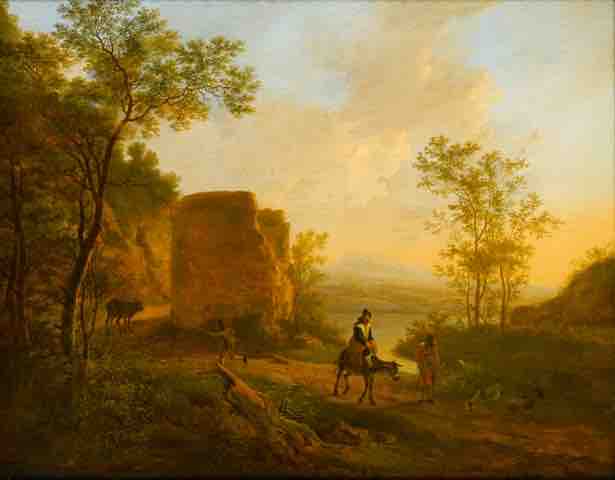Background: Dutch and Flemish Painting
Landscape painting was a major genre in the 17th century Dutch Republic that was inspired by Flemish landscapes of the 16th century, particularly from Antwerp. These Flemish works had not been particularly realistic, most having been painted in the studio, partly from imagination, and often still using the semi-aerial view style typical of earlier Netherlandish landscape painting, in the tradition of Joachim Patinir, Herri met de Bles, and Pieter Bruegel the Elder.
Dutch Landscapes
A more realistic style soon developed in the Netherlands, with lower horizons making it possible to emphasize the often impressive cloud formations so typical of the region. Favorite subjects were the dunes along the western sea coast and rivers with their broad adjoining meadows where cattle grazed, often with the silhouette of a city in the distance. Winter landscapes featured frozen canals and creeks. The sea was a favorite subject as well, holding both military and trade significance. Important early figures in the move towards realism were Esaias van de Velde (1587–1630) and Hendrick Avercamp (1585–1634).
The Tonal Phase
From the late 1620s, the "tonal phase" of landscape painting began, as artists softened or blurred their outlines and concentrated on an atmospheric effect. Great prominence was given to the sky, with human figures usually either absent or small and distant. The leading artists of this style were Jan van Goyen (1596–1656), Salomon van Ruysdael (1602–1670), Pieter de Molyn (1595–1661), and, in marine painting, Simon de Vlieger (1601–1653), with a host of minor figures.
River Scene by Jan van Goyen, 1652
Jan van Goyen was influential in the "tonal phase" of Dutch landscape painting, which was characterized by softened or blurred outlines and emphasis on the sky.
The Classical Phase
From the 1650s, the "classical phase" began, retaining the atmospheric quality but with more expressive compositions and stronger contrasts of light and color. Compositions are often anchored by a single "heroic tree," windmill, tower, or ship in marine works. The leading artist of this phase was Jacob van Ruisdael (1628–1682), who produced a great quantity and variety of work, including Nordic landscapes of dark and dramatic mountain pine forests with rushing torrents and waterfalls.
Windmill at Wijk bij Duurstede
Jacob van Ruisdael (1628–1682) was one of the most prominent artists of the classical phase of Dutch landscapes.
Other Landscape Styles
Landscapes with animals in the foreground were a distinct sub-type and were painted by Aelbert Cuyp, Paulus Potter (1625–1654), Adriaen van de Velde (1636–1672), and Karel Dujardin (1626–1678), with Philips Wouwerman painting horses and riders in various settings. The cow was a symbol of prosperity to the Dutch and, apart from the horse, by far the most commonly shown animal; goats were used to indicate Italy.
Another important type of landscape, produced throughout the tonal and classical phases, was the romantic Italianate landscape, typically in more mountainous settings than are found in the Netherlands, with golden light and sometimes picturesque Mediterranean and ruins. Jan Both (d. 1652), who had been to Rome and worked with French painter Claude Lorrain, was a leading developer of this sub-genre. Italianate landscapes were popular as prints, and more landscape paintings by painter Nicolaes Berchem were reproduced in engravings during the period itself than those of any other artist.

A Southern Landscape with a Ruin by Jan Both
Both was known for working in the Italianate landscape style.
Dutch Interior Genre Painting
Apart from landscape painting, the development and enormous popularity of genre painting is the most distinctive feature of Dutch painting during this period. These genre paintings represented scenes or events from everyday life, such as markets, domestic interiors, parties, inn scenes, and street scenes.
Genre painting developed from the realism and detailed background activity of Early Netherlandish painting, which Hieronymus Bosch and Pieter Bruegel the Elder were among the first to turn into their principal subjects. The style reflected the increasing prosperity of Dutch society, and settings grew steadily more comfortable, opulent, and carefully depicted as the century progressed.
Adriaen Brouwer is acknowledged as the Flemish master of peasant tavern scenes. Before Brouwer, peasants were typically depicted outdoors; he usually shows them in a plain and dim interior. Other artists whose common subjects were intimate interior scenes included Nicolaes Maes, Gerard ter Borch, and Pieter de Hooch. Jan Vermeer specialized in domestic interior scenes of middle class life; though he was long a very obscure figure, he is now the most highly regarded genre painter of Dutch history.

The Milkmaid by Vermeer, 1658
Vermeer is a confirmed master of Dutch genre painting known for his interior scenes of middle class life.